|
present Book Reviews For Amateur & Avocational Archaeologists |
 |
|
present Book Reviews For Amateur & Avocational Archaeologists |
 |
|
| Home | Gallery | Latest Finds | Back to Main Book Review Index |
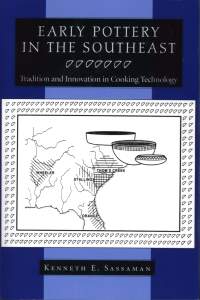
|
Early Pottery in the
Southeast Tradition and Innovation in Cooking Technology by Kenneth E. Sassaman University of Alabama Press 1993 1st ed. ISBN# 0-8173-0670-6 paperback Why was pottery invented, and why, after its invention and introduction did it take so long for it to become an established tool across regions? Early Pottery in The Southeast is a revised dissertation in which Sassaman attempts to deal with this problem. In the Southeast, most boiling was done with hot soapstone. Soapstone boiling was eventually supplanted by pottery boiling over a fire. Sassaman “employ(s) data on the distribution and use of soapstone and pottery to support the argument that soapstone exchange in the middle Savannah River Valley served to limit the adoption of pottery because its adoption represented a threat to existing exchange relationships. Initially, resistance to pottery prevented its spread into the interior; later, after being adopted in the interior, pottery was used only as a container for stone boiling. Simultaneously, coastal inhabitants outside the sphere of soapstone exchange were quick to use pots over fire, and they rapidly developed innovations to improve the thermal efficiency of pottery. I argue that socioeconomic organization on the coast was significantly different from that in the interior. Based primarily on economic arrangements that imposed constraints on the ability of individuals to fission, conditions were right for the development and rapid adotption of technological innovations that were responsive to the increased demands on personal time and labor.” This is a good book for those who wish to see the kind of thinking that examines research history of the problem, applies anthropological theory, finds exceptions, and uses hard archaeological data to create a better model for how people were living, and in Sassaman's case, perhaps a more realistic model. In a nutshell, Sassaman examines diffusionism and functionalism, two views, or theories which attempt to explain how innovation, invention and ideas become cross-cultural. He finds flaws in both views and thus sets the stage for the contents of the book. After presenting “the background, method, and analysis of Savannah River Valley Late Archaic archaeology and technology,” Sassaman returns, at the end of the book, “in Chapter 6 to evaluate my social model for the adoption of and resistance to pottery with the available data.” “Early Ceramic Vessel Technology” and “Innovations in Late Archaic Cooking Technology” were particularly interesting and informative chapters for avocationals to read. “Contexts of Early Ceramic Vessel Technology” brings it all together into a convincing model supporting the author’s argument. Amateurs and avocationalists as well as professionals, will appreciate this well written study. Another example of what can be done with theory and data, and little field work. Order Early
Pottery
in the Southeast direct from the publisher
for $36.00 by clicking here.
reviewed
by Bob
Wishoff
|
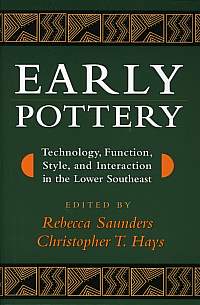
|
Early Pottery
Technology, Function, Style and Interaction in the Lower Southeast Edited by Rebecca Saunders and Christopher T. Hays University of Alabama Press 2004 1st ed. ISBN# 0-8173-5127-2 paperback Pottery and ceramics analysis has always been seen as an important information source for determining the chronology of archaeological sites. Analysis models for ceramics have stimulated critical arguments about the very nature and meaning of archaeological studies. But pottery assemblages can also reveal valuable information about the interactions between cultures, especially in regions with a well-documented archaeology. Analysis of paste compositions used to make pots, sometimes called ceramic petrology (via petrographic microscopy and geochemical analysis), as well as investigations of methods of manufacture and detailed comparison/statistical analysis of the distribution patterns of design motifs can reveal much information about cultural interactions. This is the kind of research articulated in Early Pottery. While this might seem somewhat obscure and over technical to the amateur or avocationalist unused to working with ceramics, the editors do a great job choosing papers which exploit the data within the broader contexts of their specific research problems, and thus, even the novice will find the book a suitable means to an understanding of how this research works. Understanding pottery distribution in the southeast US is important because study of this region might help throw light upon how new technologies were accepted by ancient cultures. Why was pottery not universally accepted but, instead, took hundreds of years to establish itself across the region? What were the actual functions of pottery within cultures? Did pottery start out as a practical cooking tool, or was it an example of a prestige item used more for ritual feasting, a means to “political” power and prestige? Can an examination of pottery styles and function help determine the uses of shell mounds and rings found across the region? What can pottery tell us about cooking technologies and dietary patterns? Analysis of pottery is also important for knowledge about the social structure of the peoples who used them. For example, shell ring users apparently lived within egalitarian communities where most lived in equal residential space. Burials are nearly nonexistent, and those that are known do not hold grave goods which would infer special treatment for some privileged individuals. The existence of prestige wares could show how a tradition of feasting, or sharing of excess food in ceremony, could have conferred importance and political power to an individual within an otherwise egalitarian society. All of this research is still fraught with problems. The entire issue of “first pottery” and ceramic progression generally, is up in the air. It is generally agreed that the first pottery was fiber-tempered, and came from the Savannah River Valley, disseminating outward to the coast, but that’s not necessarily the absolutely oldest beyond argument. “If abundance means importance, then the appearance of first pottery in the Lower Mississippi Valley is an extraordinarily insignificant moment, a nonevent in the history of the arts and famous chefs. A handful of early potsherds…is all we have to mark the occasion. We don’t know whether pottery appears everywhere at once, sweeps across the region like a row of toppling dominoes, or pops up like targets on a shooting range. Being scarce and isolated has not helped archaeologists figure out its chronological history either… in archaeology there’s always a chance that an older one [sherd] will turn up somewhere.” Advanced laboratory analysis techniques, such as carbon dating, petrographic analysis and advanced statistical analysis of type distributions could answer many of the research problems that have plagued archaeologists for decades and this book’s essays attempt to draw social contexts out of what’s now known. There are lots of interesting hypotheses made within the volume’s ten essays. A fine reference section rounds out the book. If you are interested in the history
of pottery
development, you will want to read this thought-provoking summary of
southeastern
early pottery research. Early Pottery
can be ordered direct from the publisher for $29.95, by clicking here.
reviewed
by Bob
Wishoff
|
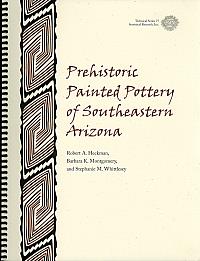
|
Prehistoric Painted
Pottery
of Southeastern Arizona By Robert A. Heckman, Barbara K. Montgomery & Stephanie M. Whittlesey University of Arizona Press 2000 1st ed. ISBN# 1-879442-77-9 spiral-bound paperback This book was intended primarily textbook for a summer course and due to the fact that not much is known about pottery from this region had to have been a daunting task for its authors: “archaeological work has been limited, the region was a cultural crossroads in prehistory, and there is considerable confusion surrounding the nomenclature of pottery in southeastern Arizona…” This made the project more than worthwhile, and we are indebted to the authors for making it available. The students who participated were lucky indeed. “Within southeastern Arizona, the guide focuses more closely on pottery from the San Pedro River region where Fort Huachuca, the Garden Canyon site, and other related sites are located.” Painted pottery from over 53 sites is represented in this guide. Note that no unpainted pottery is represented—the authors state that this is due to the lack of studies for unpainted pottery from this area. Painted pottery was made during the time period of A.D. 650 to 1450. The guide begins with a 30 page Culture History and Research Background which is quite interesting taken in on its own, after that, we are presented with detailed articulations of ten cultural traditions: Babocomari, Dragoon, San Simon, Trincheras, Tucson Basin, Hohokam Buff Ware, Mimbres Mogollon, Santa Cruz Polychrome, Roosevelt Red Ware, and Chihuahuan Polychrome. The book is filled with fine black and white drawings, as well as 10 pages of color plates. The appendix contains the entire syllabus for the course presented in 1999 -- the inspiration for the book. There is also a huge reference section for those wishing to further pursue the topic. You likely will not find this book in
your
local bookstore! Order it direct from the University of Arizona Press,
for $35.00, by clicking here.
reviewed
by Bob
Wishoff
|

|
Pottery and People A Dynamic Interaction Edited by James M. Skibo and Gary M. Feinman University of Utah Press 1999 2nd ed. ISBN# 0-87480-577-5 paperback In the introduction to this useful and interesting collection of papers, James M. Skibo writes the following: “A non-archaeologist would probably be astounded to learn the amount of time and effort prehistorians spend on the study of broken pieces of pottery. We analyze individual sherds even to the m olecular level and fill out page after page with measurements of minutia that would appear to most people as unimportant and certainly uninteresting. But what outsiders do not immediately understand is that archaeologists discovered long ago that these details collected on each piece of fired clay are our window into the lives of those who made and used these vessels.” Every sort of detail of behavior associated with pottery vessels and their research is exhibited with great clarity in the twelve excellent papers collected within this volume, papers written by individuals who are some of the most respected researchers in the field. We are shown studies of fine details of pottery paste makeup and how this relates to sourcing of materials, and how further inferences about trade versus local production can be made based upon this kind of analysis. We are also shown ethnographic studies which might prove valuable in determining whether “specialist workshops” were where prehistoric peoples made pottery, or whether individuals made them in their households. The question of just how old a person, namely children, needed to be in order to be trained as potters is also examined through ethnographic study. The design of pottery styles are also looked at from variability and chronological viewpoints, perhaps giving an indication of useage during the critical early stages of pottery use in pre-agricultural times, perhaps giving clues to the origins of pottery use. Is there symbolic “meaning” to the shapes and styles of early pottery? Food consumption is studied as a function of pottery design and complexity: is there a connection to types of feasting behaviors? Pottery and People is a fascinating cross-section of diverse pottery research methods and pottery’s complex functions in both living and ancient societies. The book is an important, classic tome which every student of arechaeology should be familiar with, because it shows clearly how inferences about behavior can be drawn from the simplest artifacts and thoughtful observation of living cultures. Part of the University of Utah Press Foundations of Archaeological Inquiry Series, Pottery and People can be ordered direct from the publisher for $25.00, by clicking here. The excellent Foundations of
Archaeological
Inquiry Series can be seen in it's entirety (and ordered) by
clicking here.
We hope to be reviewing some of the other titles in the series sometime
in the near future. reviewed
by Bob
Wishoff
|
 |
Ceramic Production in the American Southwest Edited by Barbara J. Mills & Patricia L. Crown University of Arizona Press 1995 2nd printing ISBN# 0-8165-2046-1 paperback Mills and Crown write in the introduction: “Production is the cornerstone of all economic models. Before the distribution and consumption of goods can be fully understood, the social and spatial contexts of production must be delineated.” “Ceramics are a particularly useful class of materials for investigating production in the archaeological record. They are ubiquitous components of the technological repertoire of most food-producing societies, and even some nonfood producers. Their many and varied constituents are especially useful for identifying different locations of production. Although always subject to natural and cultural formation processes, ceramics are for the most part well preserved in the archaeological record.” This book, as so many collections of papers, began with a symposium, this one being the 56th Annual Meeting of the Society for American Archaeology, a major American organization with a long history. The book therefore, is a significant one. The papers, while somewhat technical and not always immediately understandable to the amateur are nonetheless worth your time and patience. I had to read a couple of the papers several times before I really understood some of the concepts. Why ceramics were made and by whom is as important as knowing where and how they were made. How this information is inferred from the archaeological record requires that the methods and logic of research approaches be thoroughly discussed and the editors do this quite effectively in their introduction, preparing the reader for the following ten papers. It is interesting to note that no complete facility for the production of pottery has yet to be found in the southwest! Pottery manufacture and trade processes are examined in detail for Salado polychromes, Zuni pottery as well as a regional study for the North Rio Grande. An analysis of ceramic specialization and standardization is also provided. The examination of how pottery was circulated and how population movement might have affected technology transfer is one of the more interesting and readable papers. The amateur will also enjoy reading the papers on Creativity and Craft (household pottery traditions). Ceramic Production in the American Southwest effectively covers nearly a thousand years of southwestern prehistory and brings together the best of all current research to explain the complex topic of ceramic production during that time. It is an essential volume for anyone whose field of interest is southwestern ceramics. This excellent and important book can be ordered direct from the publisher for $21.95, by clicking here. reviewed by Bob Wishoff |
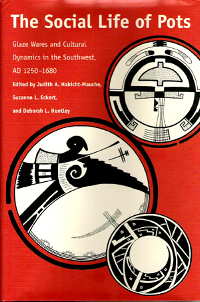 |
The Social Life of
Pots:
“The Late Precontact, or Pueblo IV, period (AD 1275-1400) in the American Southwest was marked by a series of demographic upheavals throughout the Pueblo world that resulted in the formation of a radically new social landscape. Massive migrations led to the displacement and reorganization of local communities and regional social networks as some areas, such as the Four Corners and Colorado Plateau, were completely depopulated, while others, such as the Zuni area and the Rio Grande Valley, received substantial influxes of new populations. In many areas, people from diverse ethnic, linguistic and cultural backgrounds were forced to come together to remake their social worlds from the shreds and tatters of existing cultural traditions. The proliferation and spread of new social and religious institutions and their associated rituals restructured the relationship between the individual, society, and the cosmos, leading to major transformations in notions of community, individual and corporate identity, and the nature of leadership and power in Pueblo society. Associated with these social transformations we see dramatic changes in decorated ceramic traditions throughout the Southwest. These changes reflect a distinct break with the aesthetic and technological traditions of the past.” That the migratory disruption, dispersal an re-aggregation of Pueblo cultures in protohistoric and early historic times can be traced through one of their most portable and durable artifacts---pottery---was the theme of a 2003 Society of American Archaeology symposium, and this book is an outgrowth of that meeting of some of the preeminent experts in the field. These 14 technically oriented articles, some of which are direct outgrowths of papers presented at that seminar, consider the variations in glaze wear as keys to an underlying pattern of cultural, technological and economic continuity of communities in flux. This is an academically oriented book, assuming a strong grounding in Southwestern ceramics on the part of the reader. The evolution and emergence of typological elements of glaze ware such as design styles, rim forms and paint combinations are treated not only from temporal and spatial perspectives but from cultural viewpoints as well. Ceramic assemblages are treated to a compositional analysis of localized geochemical factors affecting selection of elements such as diversity of clay sources, glaze recipes and slip colors, as well as cross cultural adoption of potting practices and technology. Ritual practices involving the utilization and exchange of glaze ware vessels receive attention, as well as the influence of trade ties and partnerships in the sharing, transition and reorganization of cultural identity. The exchange of ceramics played an important role in the developing long lasting and politically important trade ties between the hunter-gatherer societies of the Plains and eastern Pueblos. The pragmatic shifts in production and technological choices resulting from Spanish contact and the emergence of pressures related to mission based lifestyles are discussed in several chapters as well. It’s been more than 65 years since the publication of Anna Shepard’s groundbreaking Rio Grand Glaze Paint Ware: A Study Illustrating the Place of Ceramic Technological Analysis in Archaeological Research, which still stands as one of the seminal books on the subject. Her eminent contemporary Alfred Kidder referred to her work as a “bombshell…thrown into the research” and even contributed this in his foreword to her book… “But that thousands of vessels were transported many miles and evidently exchanged for some product not possessed by their makers seriously modifies our previous conception of Pueblo economics; and the making of a few vessels of foreign types in villages which already had well-standardized wares is perhaps evidence of a willingness to experiment or perhaps of the marrying of these communities of potters from other towns---in either event, important new problems are raised.” Shepard pointed the way to much that is developed more fully in this volume, and to a large extent it can be considered an outgrowth of her work analyzing paints and glazes. Although this is not necessary an easy book to fully digest, it offers much in much in understanding the significance of a deeper scientific study of Southwestern ceramic technology and distribution as a key to understanding the social life of these pots. Available from the University of Arizona Press website (click here) for $50.00, cloth hardcover, illustrated and with maps.reviewed
by Charles
Swenson
|
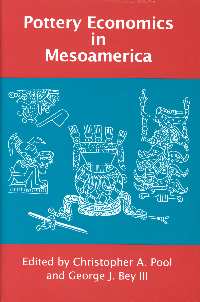 |
Pottery Economics
in Mesoamerica Edited by Christorpher A. Pool and George J. Bey III The University of Arizona Press 2007 1st edition ISBN 978-0-8165-2577-5 Cloth Hardcover Pottery is one of the most-studied type of artifact. Years of ceramic study have done much for our understanding of how ancient societies were structured, and what day-to-day life was like within them. A complex topic, pottery economics involves analysis of ethnographic and archaeological evidence for infererences of the entire cycle of production and distribution of ceramics. Trade and exchange practices, teased from these data, can inform of a ancient society's organizational structure. Pottery economics are not identical from society to society. This book seeks to focus attention on a specific region in order to highlight methods used generally to study pottery economics-- in other words to highlight how data are analyzed. Gone are the days of simple typology. As ethnographical data is integrated with archaeological data throughout the volume, this book is also a window into the practice of anthropological archaeology . The editors see Pottery Economics as a follow up to an earlier, hard-to-find volume, Ceramic Production and Distribution: An Integrated Approach-- another good reason to add this current book to your library. As with their first volume, the editors have assembled studies undertaken by the most well known and respected scholars in their fields. Order Pottery Economics directly from the publisher, for $55.00, by clicking here. reviewed by Bob Wishoff |
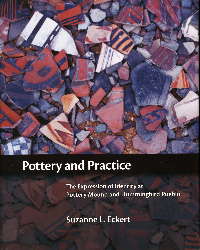 |
Pottery
and Practice The Expression of Identity at Pottery Mound and Hummingbird Pueblo by Suzanne L. Eckert University of New Mexico Press 2008 1st ed. Cloth Hardback ISBN# 978-0-6263-3834-1 This study looks at social developments during the Pueblo III (AD 1175/1200-1300) and Pueblo IV (AD 1300-1450/1500) time periods. What the author examines is what she calls a subtle, but important "distinction between 'social group' and 'social boundary'", defining social group as "a number of individuals who are classified together within a society based upon some socially meaningful characteristic that is shared by all members of the group". Social boundaries "are the conceptual and behavioral practices of individuals that divide them into social groups based upon culturally defined factors... in other words, social boundaries are the culturally defined practices of individuals that allow them to claim or deny membershipwithin a given social group." Eckert argues that her examination of techonlogical and decorative technologies aloows her to "argue that potters used their pottery to emphasize social boundaries between ethnic groups with different migration histories." What follows is an incredibly detailed analysis of pottery found at two sites: Pottery Mound and Hummingbird Pueblo. Located in central New Mexico, the 14th century sites "provide a productive area for the study of dynamic social boundaries through the lens of practice theory." Practice theory "interprets human behavior as being physical, social, and mental; individuals act as agents of practice by reproducing physical behaviors, social understanding, and mental 'know-how'." Being somewhat obvious, in a way, the practice of pottery making involves the making of many forms of pots for types of uses. Practice Theory, explains Eckert, is a viable middle-range theory that would help bridge the gap between "apparently disparate theoretical approaches", such as ecological and Marxist materialist frameworks of human behavior. What she examines, therefore, are daily routines-- pottery production, cooking, and refuse disposal. Acting out these routines, according to the author, "individuals repeatedly construct and reproduce their underlying structural principles, worldviews, and social identities." Eckert identifies a set of migraqtion and integration processes with a mind to make inferences about socioreligious organization. Tensions between groups, she argues, is evident in both the method of manufacture of pottery, and in the iconography painted on the ceramics. Whether her methodology and data set accomplishes the task is sure to be debated for some time to come. This book is an example of how to take a theoretical approach and use it to find new explanations for human behaviors. Pottery and Practice would be a valuable addition to any serious researcher of Southwestern culture. It can be ordered directlyy from the publisher for $34.95, by clicking here. reviewed by Bob
Wishoff
|
| Home | Gallery | Latest Finds | Back to Main Book Review Index |